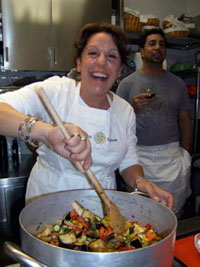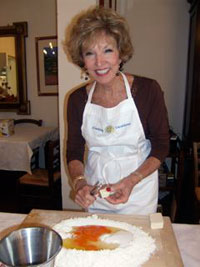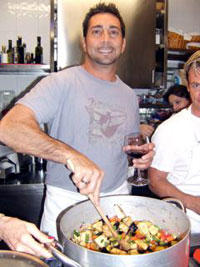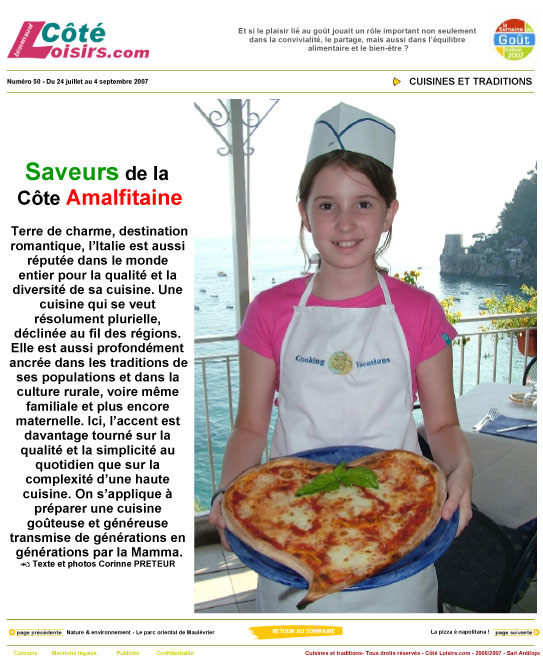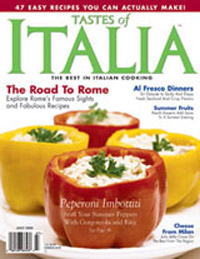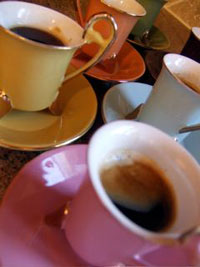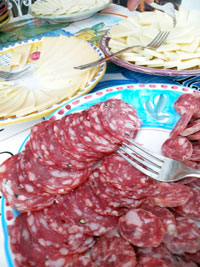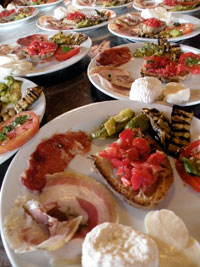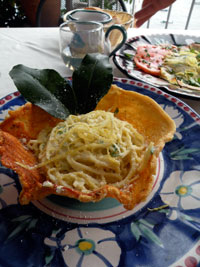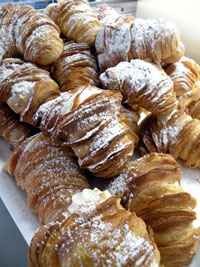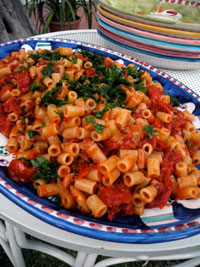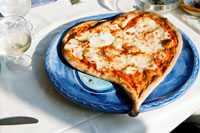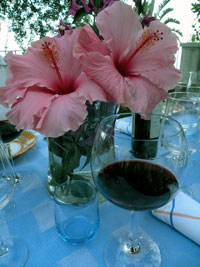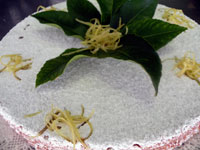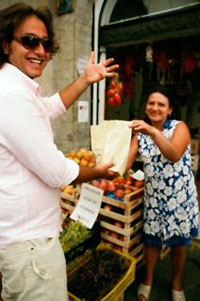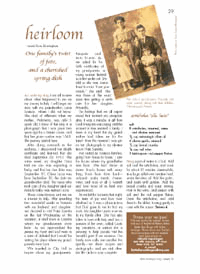Fresh Recipes, Kitchen Ideas, Food News & Fun Things To Do In Sunny Italy
Delicate pink roses, known as “the Roses of Ravello,” turn their heads to the sun in the Garden of Villa Cimbrone. Hybridized by Lucille Katherine Beckett in the 30’s (Ernest Beckett’s daughter) the rose garden is in high bloom in June. Lucille’s passion for gardening is still alive today in Villa Cimbrone, where violet and white hydrangeas huddle around small temples of Bacchus, pavilions in bronze and stone statues of life like cherubs.
Summer is (almost) here on the Amalfi Coast. And beyond the flowers, basil parsley and spring squash are blooming rapidly being picked from garden to kitchen in recipes like stuffed zucchini flowers, paccheri and zucchini and zucchini cake. Although the eggplant flowers are still in their infancy, our eggplant recipe for stuffed eggplant made the pages of Health Castle, http://www.healthcastle.com/eggplant-food-month
Trip Advisor votes Cooking Vacations the number 1 Attraction on the Amalfi Coast, Positano, so tie on your aprons and get cooking with us, http://www.tripadvisor.com/Attraction_Review-g194863-d1547896-Reviews-Cooking_Vacations_Positano_One_Day_Classes-Positano_Amalfi_Coast_Campania.html
Cooking Vacations also cooked up a storm of summer salads for Tiny Green Mom, read all about it at http://tinygreenmom.com/2011/05/orange-fennel-salad/
In honor of the Ravello Music Festival 2011, our Cooking Program of the month is Ravello ~ Music In The Kitchen™ From Garden To Kitchen With Chef Raffaele ~ 5 Day, click to read more.
Buon Appetito!
Lauren
[Table Talk]
That’s it, there’s no doubt, summer’s definitely on its way. So get planning your next trip (or your first trip!) to Italy and decide which corner of this country of marvels you want to see. Maybe one of the northern lakes where you can enjoy the background of mountains with lakeside scenery, take a boat trip along Lake Garda and taste some of the area’s seriously good olive oil. Then again, perhaps you’re a culture vulture and can’t wait to take in one of the many exhibitions organized for the 150th anniversary of the Unification of Italy in Turin, Milan or Rome. Or maybe your idea of Italy is an island break, Sicily, Sardinia, or even the elegant setting of Capri, with its wonderful shops, Roman villas and unique Mediterranean scenery. Each choice is enchanting in its own way, the product of its own particular history and setting, and has its own distinctive cuisine. And as we all know, the enjoyment of food is directly linked with its setting – the best Caprese salads are to be enjoyed in a seafront restaurant on Capri, the most delicious lobster and sea urchin in a traditional restaurant on Sardinia, and the most memorable lemon granita at a little roadside shack on the Amalfi Coast. It doesn’t have to be fancy to be unforgettable, just authentic and made from super tasty local ingredients. Truly the stuff that memories are made of.
[Food Notes]
This month, June’s newsletter brings delicious early summer vegetables and fresh fish. At the produce market stalls are piled high with the first of the year’s tomatoes, zucchini and peppers, but also all those wonderful fruits that appear for a month or so then vanish: cherries, apricots and plums. With produce this young and fresh, there’s no need to do any fancy cooking – just a few spring veggies sautéed together in a pan with a little olive oil and the first of the year’s garlic and you have the perfect dressing for risotto, pasta and or even a quick side dish. And fruit is best eaten fresh, or perhaps atop a crisp pastry crust lined with a little homemade pastry cream.
Fresh peas in particular are a true delight, each pod full to busting with its sweet emerald green cargo, and the desire to eat the peas straight out of the pod means many don’t make it from the garden to the kitchen. Like most folks in Italy, when we have a glut of anything, we do our best to enjoy our fill before the season ends, and peas are no exception. Although they can be frozen or even dried, instead we enjoy pasta with peas, risi e bisi (peas with rice), in frittatas, pea soufflé, pea purée, and delicious chilled pea and mint soup.
Even if you wouldn’t necessarily think of there being an egg season, over the last few weeks we’ve been presented with dozens and dozens of fresh eggs from family and friends whose chickens, with the arrival of the good weather, are laying so many they don’t know what to do with them. Smallish, delicate and the color of cardboard, the yolks are a beautiful sunflower yellow that brighten up dishes wherever they are used.
May and June are also the months that give us roses be they standard, tea, climbing or rambling, every sunny corner of the garden seeming to have its own little rose bush, often forgotten until the heavy red, pink and white blossoms appear and the air fills with the delicate scent of fresh roses. All around are the flowers of a much-loved pink rambler, and already thoughts turn to one our favorite treats, rose champagne. To make this, gather a few heads of one of the more perfumed rose varieties, remove the petals, rinse and add to jug of sparking white wine. Leave for 40 minutes or so in the fridge then filter and enjoy as an elegant pre-dinner drink. The same rose champagne can be used to add a special touch to a risotto along with a handful of rose petals, or to create a white wine sauce for some sautéed white fish. And of course, crystallized rose petals transform any sweet into something more sophisticated.
But whatever you decide to make, buon appetito!
[Recipes From Our Kitchen]
Fiori Di Zucchine Ripieni ~ Stuffed Zucchini Flowers
Courtesy of Il Ritrovo, Secret Garden Positano™
Serves 6
20 Zucchini flowers, cleaned & inside stem removed
Fresh Ricotta
Salt & Pepper, to taste
2 egg yolks
400g Flour
1 small beer
100g Parmesan cheese, grated
Smoked Provola cheese, grated
Salt & Pepper, to taste
Crumbled walnuts
Nutmeg
Peanut oil, for frying
Clean the zucchini flowers in cold water. Pull off prickly outside and remove inside stem gently.
Meanwhile, prepare the filling. Mix the ricotta, 1 egg yolk, crumbled walnuts, Parmesan and Provola cheese, salt and pepper together.
Fill each zucchini flower with the filling and gently twist the ends to close. Make a batter by mixing the beer, flour, 1 egg yolk, nutmeg, salt and pepper in a medium bowl.
Heat sunflower or seed oil in a large frying pan until very hot. Dip each flower in the batter and
slide each flower gently into the hot oil. Fry the flowers until golden, turning as needed to cook evenly.
Remove from oil, drain a moment on paper towel then serve immediately with a sprinkle of Parmesan cheese and chopped fresh basil, as desired.
Zucchine Alla Scapece ~ Marinated Zucchini With Mint
Courtesy of Le Tre Sorelle, Secret Garden Positano™
Serves 4
4 Zucchini, sliced into discs
6 Tbsp Sunflower or seed oil, for frying
Several leaves fresh mint, ripped by hand
1 Clove Garlic, whole, peeled
4 Tbsp White wine vinegar
Salt, to taste
In a large frying pan, heat vegetable oil until very hot. Add zucchini discs and fry until golden, about 2-3 minutes. Drain thoroughly on a paper towel.
Meanwhile, heat a frying pan. Add a whole clove of garlic and a generous bunch of mint, ripped by hand. Add the zucchini discs then a splash of white wine vinegar. Sauté together for a moment and add salt to taste. Serve immediately or allow to cool and serve tepid, as desired.
Variation: instead of sautéing the zucchini with the mint and vinegar, lay the discs in a serving platter and splash vinegar and rip mint leaves over the top. Allow to marinate about 6 hours or until ready to serve.
Paccheri Con Zucchine E Provola Affumicata ~ Paccheri Pasta With Zucchini & Smoked Provola
Courtesy of Le Tre Sorelle, Secret Garden Positano™
Serves 4
4 zucchini
150 g Parmigiano Reggiano, grated
150 g Smoked Provola cheese
1 L sunflower or peanut oil, for frying
100 mL heavy cream
50 g butter
Extra Virgin Olive Oil
1 onion
Fresh Basil
Salt & Pepper, to taste
400 g Paccheri Pasta
Slice the zucchini into rounds. Sprinkle them with salt and allow them to sit 10 minutes. Rinse under water then pat dry.
In a frying pan, heat sunflower or peanut oil until very hot. Fry the zucchini rounds until golden, then remove and drain on paper towel to remove excess oil.
Slice the onion finely and sauté in a little bit of olive oil and a pat of butter in a large frying pan. Add the fried zucchini, salt, pepper and heavy cream.
Meanwhile, cook the Paccheri pasta in boiling salted water until al dente. Drain the pasta and add to the pan with the zucchini. Add the grated Parmigiano, the Provola and toss together. Garnish with fresh basil and serve.
Dolcini Al Cocco ~ Coconut Ricotta Balls
Courtesy of Chef Raffaella, A Precious Vineyard Above The Sea™
Makes about 40 balls
200 g Ricotta
200 g Sugar
200 g Coconut + additional for dusting
In a mixing bowl, mix Ricotta, sugar and coconut until smooth. Roll teaspoonfuls of the Ricotta mixture into balls, and roll in coconut. Place on serving dish and chill in the refrigerator until ready to serve.
Variation: add 1-2 tbsp cocoa powder (until desired color) to half of the Ricotta mixture, to make half white and have chocolate balls.
[With Love From Italy]
Visit Rome’s Cinecittà
On the occasion of the 150th anniversary of the Unification of Italy, Cinecittà, the home of Italian cinema, is opening its doors to visitors for the very first time until April 2011. This is the place that has been turning dreams into reality since it opened in 1937, boasting productions by filmmakers such as Federico Fellini, Roberto Rossellini, Luchino Visconti, Bernardo Bertolucci, as well as Francis Ford Coppola, Martin Scorsese, Mel Gibson and Anthony Minghella.
www.cinecittasimostra.it
Venice’s First Ever ‘White Night’
Venice has announced that on the 18th June it will join the list of cities holding a ‘White Night’ where local galleries and museums will be open from dusk till dawn and offer free admittance. Visit the Guggenheim Museum, Museo Vedova, Galleria dell’Accademia, Palazzo Grassi and many city libraries, historical archives and university laboratories. An event that’s not to be missed!
http://virgo.unive.it/artnightvenezia
Savor Syracuse
The tradition of classic Greek plays in the amazing atmosphere of Syracuse’s Greek theatre continues this year in this, the 47th cycle of classical plays. Until the 26th June it will be possible to take in Sophocles’ Philoctetes, Aristophanes’ The Clouds and Euripedes’ Andromache all of which aim to bring back to life the ancient heroes of Greek tradition.
www.indafondazione.org
Herculaneum
Visitors to Herculaneum will be delighted to learn that the site’s impressive Roman high street Decumanus Maximus has been reopened after 20 years of being off limits to the public. Along its length is the House of the Double Porticos which retains original, charred wooden beams and shutters and concludes with a triumphal arch.
http://www.pompeiisites.org
[Italian Feasts And Celebrations]
This month, we take a look at some great food festivals to suit all tastes this June in Italy.
Sagra Della Patata: San Nicolò (FE), 9 – 19 June. Whoever thinks that potatoes are a boring food should visit this festival where the townsfolk of San Nicolò will do their best to transform this apparently modest ingredient into a series of delicious dishes: from antipasto to sweet, potatoes will be the main ingredient in all the dishes on offer (including potato jam served with cheeses!), and there will even be a potato liqueur to finish off the meal in style!
Festa Delle Erbe Di Primavera: Forni di Sopra (UD), 12th and 19th June. Elderflower aperitvi, antipasti of mountain radicchio, herb risottos, polenta with wild herbs, chive fritters, nettle bread, rhubarb tart, cumin grappa – all these wonderful sounding creations will be on offer at this Spring herb sagra in the Alpine town of Forni di Sopra. Meetings and workshops mean you can learn more about this area’s wild herbs and how to use and conserve them, and of course there will be local products and specialties for sale.
Sagra Dell’Asparago E Fungo Porcino: Montoro Superiore (AV), 17th and 19th June. No serious foodie could resist the sound of this food festival celebrating asparagus and porcini mushrooms which is held in the province of Avellino. The organizers also take it seriously and provide over 1,500 seated places at tables so visitors can take the weight off their feet and concentrate on enjoying the many specialties on offer.
7th Sagra Del Pesto: Saignone (GE), 24th and 25th June. We think that you should go to at least one pesto sagra while you’re in Italy, as surely nothing could be more delightful than sampling one of Italy’s best loved products in its region of origin. In the town of Saignone near Genova, you’ll be treated to a selection of pasta dishes dressed with the area’s fragrant pesto as well as grilled meat and vegetables and local wine, with local bands providing music. (Celiacs will also be catered for, with gluten-free pasta.)
[Italy On A Plate]
By Germaine Stafford
Germaine continues her roundup of what’s happening in the culinary world in Italy and gives you her chef of the month, book recommendation, and a list of seasonal foods for June.
What’s in Season?
Lamb
Sea Bream
Sardines
Salmon
Mullet
Crab
New potatoes
Peas
Rocket
Mint
Gooseberries
Cherries
Zucchini
Peppers
Elderflowers
[Restaurant Of The Month]
Osteria Gazza Ladra, Siracusa
This month we thought we’d recommend a fabulous little osteria – wine bar not far from the Duomo in Siracusa that would be perfect for anyone deciding to spend a few days in this lovely Sicilian town and maybe take in one of the classic Greek plays at the Greek theater. La Gazza Ladra is run by the husband and wife team of Marcello Foti and Maria Grazia Troncon, and their kitchen gives straight on to the small dining room so diners can watch them cook. Food here is gloriously simple and based on local ingredients, and rest assured this translates into unpretentious dishes that fairly burst with the flavors of Sicily.
Although you can pop in for just a snack and a glass of wine, we recommend you take the time to try out something from their menu. Starters include the classic eggplant caponata, dried tomatoes, grilled or baked vegetables, fennel and orange salad, a selection of local cheeses and salumi or maybe a ricotta and mint frittata. First courses depend on the season, but might include vegetable and bean soup, country-style fava bean and borage soup, pasta alla siracusana with anchovies, breadcrumbs and tomato concentrate, pasta alla Norma with eggplant and salted ricotta, pasta with fresh sardines or with cuttlefish ink. Second dishes cover staples such as oven roasted pork sausages with potatoes, veal involtini, grilled tuna or silver scabbard fish (delicious!), octopus salad or fresh anchovies baked with citrus fruit. Desserts are homemade and we suggest you try those based on local almonds. The wine list is fairly brief but also offers some good choices by the glass. All in all, a great little hole in the wall stop for the hungry visitor.
Further Information:
Osteria La Gazza Ladra
Via Cavour, 8
Siracusa
Tel. +39-340-0602428
[Book Of The Month]
Biscotti by Lou Seibert
There are some books you find yourself reaching for time and time again, and Lou Seibert’s Biscotti is one such book. It’s been on my shelf for years, but whether it’s mid winter and I’m looking for a way to end a warming meal with friends, or I simply need to replenish the cookie jar to have something to hand when guests pop in unexpectedly, it’s a treasure trove of ideas. Part of the appeal is the versatility of biscotti – elegant enough to serve at a dinner party as an accompaniment to homemade ice cream or a glass of Vin Santo, but also perfect for dipping into a steaming cappuccino and calling breakfast. Large glass jars filled with biscotti make a beautiful addition to any kitchen, and it’s great to have some to hand for crushing and sprinkling over ice cream or even wrapping up as a pretty gift for friends.
The word biscotti means cooked twice, and all the cookies in the book are first baked in a log shape then cut diagonally into small slices and returned to the oven for a second baking. This ensures they are deliciously crisp, but also that they store very well. Naturally, traditional biscotti are covered in the book, with almond and vanilla biscotti from Tuscany, anise seed biscotti from Sicily, and the delicious sounding pine nut and lemon biscotti. Chocolate is a favorite biscotti ingredient, especially paired with almonds, hazelnuts, coffee and, of course, more chocolate. Then there is a selection of biscotti with other less traditional ingredients: Moorish apricot delight, Orange almond diamonds, Triple ginger lovers’ biscotti, pistachio and golden raisin biscotti and even Swedish cinnamon slices. There are also a few healthy options such as fruited nut bars and granola biscotti to finish up, making this a small but complete biscotti reference book and the perfect inspiration for creating delicious biscotti combinations of your own.
“




















